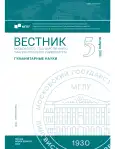A Poet Translating Poet and the Concept of Translator’s Visibility (a case-study of Arkadii Dragomoshchenko’s translation of Lyn Hejinian’s poems)
- Authors: Ustinova T.V.1
-
Affiliations:
- Lomonosov Moscow State University
- Issue: No 5(886) (2024)
- Pages: 124-129
- Section: Linguistics
- URL: https://journal-vniispk.ru/2542-2197/article/view/303558
- ID: 303558
Cite item
Full Text
Abstract
In the article, individual linguistic and stylistic-textual features characteristic of the speech of the poet as an elite linguistic personality are examined in terms of their manifestation in the translated target text. Using the example of Arkadii Dragomoshchenko’s translations from English into Russian, the article examines the influence of the poet’s idiostyle dominants on the strategies of creative interlingual mediation in the process of poetic translation.
About the authors
Tatiana Viktorovna Ustinova
Lomonosov Moscow State University
Author for correspondence.
Email: utanja@mail.ru
Doctor of Philology, Associate professor, Associate Professor at the Department of Linguistics, Translation and Intercultural Communication
Russian FederationReferences
- Schweitzer, A. D. (1994). Perevod i kul’turnaja tradicija = Translation and cultural tradition. In Perevod i lingvistika teksta (pp. 64–76). Moscow: Vserossijskij centr perevodov. (In Russ.)
- Venuti L. (1995). The Translator’s Invisibility. A History of Translation. London: Routledge.
- Sorokin, Ju. A. (2003). Perevodovedenie: status perevodchika i psihogermenevticheskie procedury = Translation studies: the status of the translator and psychohermeneutic procedures. Moscow: Gnozis. (In Russ.)
- Grigorev, V. P. (2006). Jazyk kak tvorchestvo = Language as creativity. In V. P. Grigor’ev. Velimir Hlebnikov v chetyrehmernom prostranstve jazyka: Izbrannye raboty. 1958–2000 gody (pp. 233–235). Moscow: Jazyki slavjanskih kul’tur. (In Russ.)
- Hejinian, L. (2013). Po tu storonu konechnosti. Pamjati Arkadija Dragomoshhenko = In memoriam of Arkadii Dragomoshchenko. Novoe literaturnoe obozrenie, 121. https://www.nlobooks.ru/magazines/novoe_literaturnoe_ obozrenie/121_nlo_3_2013/article/10445/ (date of access: 15.12.2023). (In Russ.)
- Skidan, A. (2013). Syr bukv mel = The chalk of letters is wet. Novoe literaturnoe obozrenie, 121. URL: https:// www.nlobooks.ru/magazines/novoe_literaturnoe_obozrenie/121_nlo_3_2013/article/10447/ (date of access: 15.12.2023). (In Russ.)
- Pimenova, M. V. (2011). K voprosu o leksiko-semanticheskom sinkretizme (pp. 9–13) = To the issue of lexicosemantic syncretism. Russkij jazyk: sistema i funkcionirovanie: collection of papers of the 5th International scientific conference. Minsk: BGU. (In Russ.)
- Zaliznjak, A. A. (2004). Fenomen mnogoznachnosti i sposoby ego opisanija = The phenomenon of polysemy and methods of its description. Voprosy jazykoznanija, 2, 20–45. (In Russ.)
- Ustinova, T. V. (2022). Leksicheskaja sochetaemost’ v stihotvorenijah Arkadija Dragomoshhenko: kognitivnosemanticheskij analiz = Lexical compositionality in Arkadii Dragomoshchenko’s poems: The cognitive semantic analysis. Vestnik Moskovskogo gosudarstvennogo oblastnogo universiteta. Serija: Russkaja filologija, 3, 59–67. (In Russ.)
- Ustinova, T. V. (2023). Metonimicheskie transformacii v perevode s kognitivnoj tochki zrenija = Metonymic transformations in translation: A cognitive semantics perspective. Kognitivnye issledovanija jazyka, 4(55), 1017 1021. (In Russ.)
- Sun B., Yue M. (2023). The translator’s visibility: A stylistic perspective. Across Languages and Cultures, 24(1), 52–72.
- Lynch G., Vogel C. (2018). The translator’s visibility: Detecting translatorial fingerprints in contemporaneous parallel translations. Computer Speech & Language, 52, 79–104.
Supplementary files










